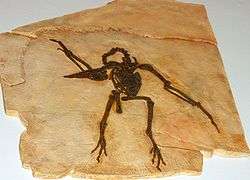Lithornithidae
Lithornithidae is an extinct, possibly paraphyletic[1] (but see below) clade of early paleognath birds. They are known from fossils dating to the Upper Paleocene through the Middle Eocene of North America and Europe, with possible Late Cretaceous representatives.[1][2] All are extinct today;[3] the youngest specimen is the currently unnamed SGPIMH MEV1 specimen from the mid-Eocene Messel Pit site.[4]
| Lithornithidae | |
|---|---|
 | |
| Pseudocrypturus cercanaxius fossil cast, Zoologisk Museum, Copenhagen | |
| Scientific classification | |
| Kingdom: | Animalia |
| Phylum: | Chordata |
| Class: | Aves |
| Order: | †Lithornithiformes |
| Family: | †Lithornithidae Houde, 1988 |
| Genera | |
|
Calciavis | |
Lithornithids had long, slender, bills for probing. They closely resembled modern tinamous. They possessed a rhynchokinetic skull with relatively unfused cranial bones, a weakly fused pygostyle and a splenial. The unguals were more curved than in tinamous and probably allowed better perching in trees.
The order Lithornithiformes was erected by Dr. Peter Houde in 1988. Initially, only three genera (Lithornis, Paracathartes, and Pseudocrypturus) and eight named species were included.[3] Promusophaga (Harrison & Walker, 1977) originally considered a stem-turaco, is considered synonymous with Lithornis vulturinus. Fissuravis may also belong to the clade,[5] and several unnamed remains are known.
Taxonomy
Lithornithiformes Houde, 1988[6][7]
- †Lithornithidae Houde, 1988 (False tinamous)
- †Calciavis grandei Nesbitt, 2016
- †Fissuravis weigelti Mayr, 2007
- †Paracathartes howardae Harrison, 1979 (Early Eocene of WC US)
- †Pseudocrypturus cercanaxius Houde, 1988
- †Lithornis Owen, 1840 [Promusophaga Harrison & Walker, 1977; Pediorallus Harrison, 1984; Parvigyps Harrison & Walke,r 1977] (Paleocene – Early Eocene)
- †L. celetius Houde, 1988
- †L. plebius Houde, 1988
- †L. promiscuous Houde, 1988
- †L. nasi (Harrison, 1984) Houde, 1988 [Pediorallus nasi Harrison, 1984]
- †L. hookeri (Harrison, 1984) Houde, 1988 [Pediorallus hookeri Harrison, 1984]
- †L. vulturinus Owen, 1840 [Parvigyps praecox Harrison & Walker, 1977; Promusophaga magnifica Harrison & Walker, 1977; Pediorallus barbarae Harrison & Walker, 1977a] (London Clay Early Eocene of England)
Several studies have shown conflicting status on the monophyly of the group. Some studies recover them as a paraphyletic assemblage leading to modern paleognaths,[1] but more recent examinations group them in a single, natural group basal to the rest of Palaeognathae.[8] Of issue is Paracathartes, which differs radically from other lithornithids and has been suggested to more closely related to extant paleognaths,[9] though it is recently recovered as a derived lithornithid.[10][note 1]
Lithornis itself may be paraphyletic in relation to Paracathartes and Pseudocrypturus.[10]
Paleobiology
In a study about ratite endocasts, Lithornis ranks among the taxa with well developed olfactory lobes. This is consistent with a nocturnal, forest-dwelling lifestyle, though as much all volant birds it retains large optical lobes.[11]
Unlike modern tinamous, at least Lithornis has toe claws and reversed halluxes that allow for efficient perching.[1]
Several egg fossils have been attributed to lithornithid birds.[1] Both Lithornis and Paracathartes have entire nests assigned to them.[12] Their eggshells are, perhaps unsurprisingly, noted as being "ratite-like".[13]
Studies on lithornithid feathers shows that some species had gloss similar to that of cassowaries.[14]
Notes
- This particular study defaults to the traditional paleognath classification scheme, based on the similarities with tinamous. The more recent genetic revaluations are vindicated, however, in that it recognises that the features uniting lithornithids to tinamous in the study are most likely basal to paleognaths as a whole.
References
- Paleogene Fossil Birds
- A lithornithid (Aves: Palaeognathae) from the Paleocene (Tiffanian) of southern California
- Houde, Peter W. (1988). "Paleognathous Birds from the Early Tertiary of the Northern Hemisphere". Publications of the Nuttall Ornithological Club. Cambridge Massachusetts, USA: Nuttall Ornithological Club. 22.
- "First substantial Middle Eocene record of the Lithornithidae (Aves): A postcranial skeleton from Messel (Germany)" (PDF). Archived from the original (PDF) on 2011-06-10. Retrieved 2016-06-11.
- Gerald Mayr, Paleogene Fossil Birds
- Mikko's Phylogeny Archive Haaramo, Mikko (2007). "Paleognathia - paleognathous modern birds". Retrieved 30 December 2015.
- "Taxonomic lists- Aves". Paleofile.com. Archived from the original on 11 January 2016. Retrieved 30 December 2015.
- Nesbitt, Sterling J.; Clarke, Julia A., The anatomy and taxonomy of the exquisitely preserved Green River Formation (early Eocene) lithornithids (Aves) and the relationships of Lithornithidae. (Bulletin of the American Museum of Natural History, no. 406), 2016-06-30
- Houde, Peter W. (1988). "Paleognathous Birds from the Early Tertiary of the Northern Hemisphere". Publications of the Nuttall Ornithological Club (Cambridge, MA)
- Worthy, Trevor H.; Mitri, Miyess; Handley, Warren D.; Lee, Michael S. Y.; Anderson, Atholl; Sand, Christophe; Evans, Alistair Robert (30 March 2016). "Osteology Supports a Stem-Galliform Affinity for the Giant Extinct Flightless Bird Sylviornis neocaledoniae (Sylviornithidae, Galloanseres)". PLOS ONE. 11 (3): e0150871. doi:10.1371/journal.pone.0150871.
- Torres, Christopher R.; Clarke, Julia A. (31 October 2018). "Nocturnal giants: evolution of the sensory ecology in elephant birds and other palaeognaths inferred from digital brain reconstructions". Proceedings of the Royal Society B: Biological Sciences. 285 (1890): 20181540. doi:10.1098/rspb.2018.1540.
- Houde, Peter W. (1988). "Paleognathous Birds from the Early Tertiary of the Northern Hemisphere". Publications of the Nuttall Ornithological Club (Cambridge, MA) 22.
- Grellet-Tinner, Gerald; Dyke, Gareth J. (2005). "The eggshell of the Eocene bird Lithornis - Acta Palaeontologica Polonica". Acta Palaeontologica Polonica. 50 (4): 831–835.
- Eliason, Chad M.; Clarke, Julia A. (13 May 2020). "Cassowary gloss and a novel form of structural color in birds". Science Advances. 6 (20). doi:10.1126/sciadv.aba0187. PMC 7220335.